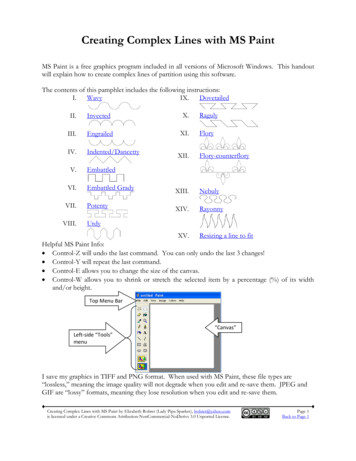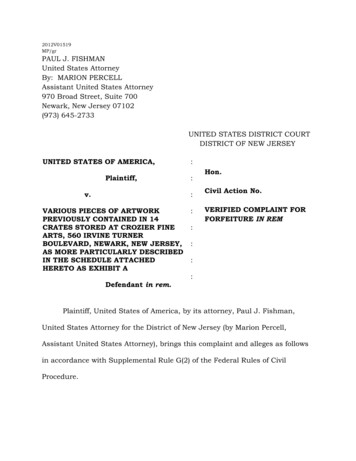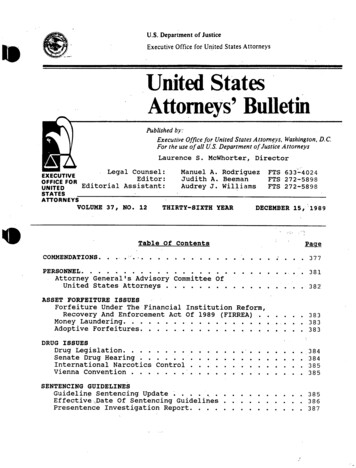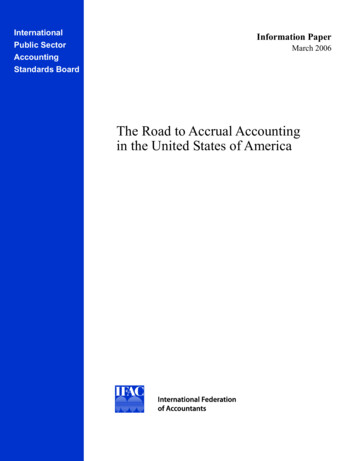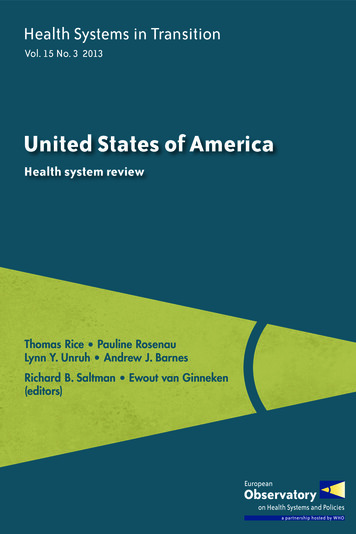
Transcription
Health Systems in TransitionVol. 15 No. 3 2013United States of AmericaHealth system reviewThomas Rice Pauline RosenauLynn Y. Unruh Andrew J. BarnesRichard B. Saltman Ewout van Ginneken(editors)
Richard B. Saltman and Ewout van Ginneken (Editors) and Reinhard Busse (Series editor)were responsible for this HiTEditorial BoardSeries editorsReinhard Busse, Berlin University of Technology, GermanyJosep Figueras, European Observatory on Health Systems and PoliciesMartin McKee, London School of Hygiene & Tropical Medicine, United KingdomElias Mossialos, London School of Economics and Political Science, United KingdomSarah Thomson, European Observatory on Health Systems and PoliciesEwout van Ginneken, Berlin University of Technology, GermanySeries coordinatorGabriele Pastorino, European Observatory on Health Systems and PoliciesEditorial teamJonathan Cylus, European Observatory on Health Systems and PoliciesCristina Hernández-Quevedo, European Observatory on Health Systems and PoliciesMarina Karanikolos, European Observatory on Health Systems and PoliciesAnna Maresso, European Observatory on Health Systems and PoliciesDavid McDaid, European Observatory on Health Systems and PoliciesSherry Merkur, European Observatory on Health Systems and PoliciesPhilipa Mladovsky, European Observatory on Health Systems and PoliciesDimitra Panteli, Berlin University of Technology, GermanyWilm Quentin, Berlin University of Technology, GermanyBernd Rechel, European Observatory on Health Systems and PoliciesErica Richardson, European Observatory on Health Systems and PoliciesAnna Sagan, European Observatory on Health Systems and PoliciesInternational advisory boardTit Albreht, Institute of Public Health, SloveniaCarlos Alvarez-Dardet Díaz, University of Alicante, SpainRifat Atun, Harvard University, United StatesJohan Calltorp, Nordic School of Public Health, SwedenArmin Fidler, The World BankColleen Flood, University of Toronto, CanadaPéter Gaál, Semmelweis University, HungaryUnto Häkkinen, Centre for Health Economics at Stakes, FinlandWilliam Hsiao, Harvard University, United StatesAllan Krasnik, University of Copenhagen, DenmarkJoseph Kutzin, World Health OrganizationSoonman Kwon, Seoul National University, Republic of KoreaJohn Lavis, McMaster University, CanadaVivien Lin, La Trobe University, AustraliaGreg Marchildon, University of Regina, CanadaAlan Maynard, University of York, United KingdomNata Menabde, World Health OrganizationEllen Nolte, Rand Corporation, United KingdomCharles Normand, University of Dublin, IrelandRobin Osborn, The Commonwealth Fund, United StatesDominique Polton, National Health Insurance Fund for Salaried Staff (CNAMTS), FranceSophia Schlette, Federal Statutory Health Insurance Physicians Association, GermanyIgor Sheiman, Higher School of Economics, Russian FederationPeter C. Smith, Imperial College, United KingdomWynand P.M.M. van de Ven, Erasmus University, The NetherlandsWitold Zatonski, Marie Sklodowska-Curie Memorial Cancer Centre, Poland
Health Systemsin TransitionThomas Rice, Fielding School of Public Health,University of California, Los AngelesPauline Rosenau, School of Public Health, Health Science Center,University of Texas, HoustonLynn Y. Unruh, Department of Health Management and Informaticsat the University of Central FloridaAndrew J. Barnes, Virginia Commonwealth University School of MedicineEditors:Richard B. Saltman, Emory University in Atlanta and European Observatoryon Health Systems and PoliciesEwout van Ginneken, Berlin University of Technology and EuropeanObservatory on Health Systems and PoliciesUnited States of America:Health System Review2013The European Observatory on Health Systems and Policies is a partnership, hosted by theWHO Regional Office for Europe, which includes the Governments of Belgium, Finland,Ireland, the Netherlands, Norway, Slovenia, Spain, Sweden, the United Kingdom and theVeneto Region of Italy; the European Commission; the European Investment Bank; the WorldBank; UNCAM (French National Union of Health Insurance Funds); the London School ofEconomics and Political Science; and the London School of Hygiene & Tropical Medicine.
Keywords:DELIVERY OF HEALTH CAREEVALUATION STUDIESFINANCING, HEALTHHEALTH CARE REFORMHEALTH SYSTEM PLANS – organization and administrationUNITED STATES OF AMERICA World Health Organization 2013 (acting as the hostorganization for, and secretariat of, the EuropeanObservatory on Health Systems and Policies).All rights reserved. The European Observatory on HealthSystems and Policies welcomes requests for permissionto reproduce or translate its publications, in part or in full.Please address requests about the publication to:Publications,WHO Regional Office for Europe,UN City, Marmorvej 51,DK-2100 Copenhagen Ø, DenmarkAlternatively, complete an online request form fordocumentation, health information, or for permissionto quote or translate, on the Regional Office web blication-request-forms).The views expressed by authors or editors do notnecessarily represent the decisions or the stated policiesof the European Observatory on Health Systems andPolicies or any of its partners.The designations employed and the presentation of thematerial in this publication do not imply the expressionof any opinion whatsoever on the part of the EuropeanObservatory on Health Systems and Policies or any ofits partners concerning the legal status of any country,territory, city or area or of its authorities, or concerningthe delimitation of its frontiers or boundaries. Where thedesignation “country or area” appears in the headings oftables, it covers countries, territories, cities, or areas.Dotted lines on maps represent approximate border linesfor which there may not yet be full agreement.The mention of specific companies or of certainmanufacturers’ products does not imply that they areendorsed or recommended by the European Observatoryon Health Systems and Policies in preference to othersof a similar nature that are not mentioned. Errors andomissions excepted, the names of proprietary productsare distinguished by initial capital letters.The European Observatory on Health Systems and Policiesdoes not warrant that the information contained in thispublication is complete and correct and shall not be liablefor any damages incurred as a result of its use.Printed and bound in the United Kingdom.Suggested citation:Rice T, Rosenau P, Unruh LY, Barnes AJ, Saltman RB, van Ginneken E.United States of America: Health system review. Health Systems inTransition, 2013; 15(3): 1– 431.ISSN 1817–6127 Vol. 15 No. 3
ContentsContentsPreface vAcknowledgements viiList of abbreviations ixList of tables, figures and boxes xvAbstract xixExecutive summary xxi1. Introduction 11.1 Geography and sociodemography 11.2 Economic context 51.3 Political context 81.4 Health status 112. Organization and governance 2.1 Overview of the health-care system 2.2 Historical background 2.3 Organization 2.4 Decentralization and centralization 2.5 Planning 2.6 Intersectorality 2.7 Health information management 2.8 Regulation 2.9 Patient empowerment 252633404754596370803. Financing 913.1 Health expenditure 923.2 Sources of revenue, financing and financial flows 1023.3 Medicare 1083.4 Medicaid 1203.5 Private health insurance 1303.6 Out-of-pocket payments 1463.7 Payment mechanisms 148
ivHealth systems in transition United States of America4. Physical and human resources 1594.1 Physical resources 1604.2 Human resources 1815. Provision of services 2075.1 Patient pathways 2085.2 Public health 2155.3 Outpatient services: primary care 2245.4 Outpatient services: specialty care 2325.5 Outpatient services: ambulatory surgical, emergency and urgent care 2355.6 Acute inpatient care 2405.7 Dental care 2485.8 Mental health care 2515.9 Pharmaceutical care 2565.10 Post-acute care: rehabilitation, intermittent home care and subacute care 2595.11 Long-term care 2645.12 Palliative care 2725.13 Complementary and alternative medicine 2745.14 Services from informal care-givers 2795.15 Health services for specific populations 2816. Principal health reforms 2916.1 History of United States health reforms 2926.2 The Affordable Care Act 3006.3 Vulnerabilities during implementation 3156.4 The future of the ACA 3197. Assessment of the health system 3217.1 Stated objectives of the health system 3227.2 Financial protection: access and equity 3237.3 Health outcomes, health services outcomes and quality of care 3377.4 Health system expenditures and out-of-pocket costs 3607.5 Health system efficiency 3678. Conclusions 3739. Appendices 3759.1 References 3759.2 Useful web sites 4259.3 HiT methodology and production process 4279.4 The review process 4299.5 About the authors 430
The Health Systems in Transition (HiT) series consists of country-basedreviews that provide a detailed description of a health system and ofreform and policy initiatives in progress or under development in aspecific country. Each review is produced by country experts in collaborationwith the Observatory’s staff. In order to facilitate comparisons betweencountries, reviews are based on a template, which is revised periodically. Thetemplate provides detailed guidelines and specific questions, definitions andexamples needed to compile a report.HiTs seek to provide relevant information to support policy-makers andanalysts in the development of health systems in Europe. They are buildingblocks that can be used: to learn in detail about different approaches to the organization, financingand delivery of health services and the role of the main actors inhealth systems; to describe the institutional framework, the process, content andimplementation of health-care reform programmes; to highlight challenges and areas that require more in-depth analysis; to provide a tool for the dissemination of information on health systemsand the exchange of experiences of reform strategies between policymakers and analysts in different countries; and to assist other researchers in more in-depth comparative healthpolicy analysisCompiling the reviews poses a number of methodological problems. Inmany countries, there is relatively little information available on the healthsystem and the impact of reforms. Due to the lack of a uniform data source,quantitative data on health services are based on a number of different sources,PrefacePreface
viHealth systems in transition United States of Americaincluding the World Health Organization (WHO) Regional Office for Europe’sEuropean Health for All database, data from national statistical offices,Eurostat, the Organisation for Economic Co-operation and Development(OECD) Health Data, data from the International Monetary Fund (IMF), theWorld Bank’s World Development Indicators and any other relevant sourcesconsidered useful by the authors. Data collection methods and definitionssometimes vary, but typically are consistent within each separate review.A standardized review has certain disadvantages because the financingand delivery of health care differ across countries. However, it also offersadvantages, because it raises similar issues and questions. HiTs can be used toinform policy-makers about experiences in other countries that may be relevantto their own national situation. They can also be used to inform comparativeanalysis of health systems. This series is an ongoing initiative and material isupdated at regular intervals.Comments and suggestions for the further development and improvementof the HiT series are most welcome and can be sent to info@obs.euro.who.int.HiTs and HiT summaries are available on the Observatory’s web site (http://www.healthobservatory.eu).
The Health Systems in Transition (HiT) profile on the United States waswritten by Thomas Rice (University of California, Los Angeles), PaulineRosenau (University of Texas), Lynn Unruh (University of Central Florida)and Andrew Barnes (Virginia Commonwealth University). It was edited byEwout van Ginneken (Berlin University of Technology) and Richard Saltman(Emory University). The Research Director for this HiT was Reinhard Busse(Berlin University of Technology).The European Observatory on Health Systems and Policies is grateful toGerard Anderson (Johns Hopkins University), Lawrence D. Brown (ColumbiaUniversity), Nick Fahy (Independent consultant and researcher), Jon Gabel(NORC at the University of Chicago), George Greenberg (U.S. Departmentof Health and Human Services, Office of the Assistant Secretary for Health –ASPE), Richard Kronick (ASPE), Jonathan Oberlander (University of NorthCarolina-Chapel Hill), Mark Peterson (University of California, Los Angeles),Marc Rodwin (Suffolk University Law School), Richard Scheffler (Universityof California, Berkeley), Katherine Swartz (Harvard University), and LeonWyszewianski (University of Michigan) for reviewing all or part of thereport. All opinions are those of the authors and do not reflect the views ofthe reviewers. The authors are also grateful to Beth Umland of Mercer forproviding information on the scope of private insurance coverage for Chapter 3.Thomas Rice thanks the Rockefeller Foundation for providing him with aresidency at its Bellagio Center in Italy, during which he worked on Chapter 7of the book. Pauline Rosenau thanks the University of Otago Medical Schoolin New Zealand for setting time aside to work on the book during her WilliamEvans Visiting Fellowship. Lynn Unruh thanks the University of CentralFlorida for providing a sabbatical to work on Chapters 4 and 5 of the book.AcknowledgementsAcknowledgements
viiiHealth systems in transition United States of AmericaEwout van Ginneken thanks the Commonwealth Fund for allowing him to workon this HiT while on a Commonwealth Fund Harkness Fellowship in HealthCare Policy and Practice at the Harvard School of Public Health.The current series of HiT profiles has been prepared by the staff of theEuropean Observatory on Health Systems and Policies. The EuropeanObservatory on Health Systems and Policies is a partnership between theWHO Regional Office for Europe, the Governments of Belgium, Finland,Ireland, the Netherlands, Norway, Slovenia, Spain, Sweden, the UnitedKingdom and the Veneto Region of Italy, the European Commission, theEuropean Investment Bank, the World Bank, UNCAM (French NationalUnion of Health Insurance Funds), the London School of Economics andPolitical Science, and the London School of Hygiene & Tropical Medicine.The Observatory team working on the HiT profiles is led by Josep Figueras,Director, and Elias Mossialos, Co-Director, and heads of the Research HubsMartin McKee, Reinhard Busse and Richard Saltman. The production andcopy-editing process was coordinated by Jonathan North, with the support ofCaroline White, Mary Allen (copy-editing), Steve Still (design and layout) andSarah Cook (proofreading).Special thanks are extended to the OECD Health Data from whichinternational data on health and health services were extracted; and to theCommonwealth Fund for data from their International Health Policy Surveys.The HiT reflects data available in November 2012.
AbbreviationsAARPAmerican Association of Retired PersonsABMSAmerican Board of Medical SpecialistsACAAffordable Care ActACAOMAccreditation Commission for Acupuncture and Oriental MedicineACOAccountable Care OrganizationADAAmericans with Disabilities ActADLsactivities of daily livingADNAssociate Degree in NursingAHAAmerican Hospital AssociationAHIPAmerica’s Health Insurance PlansAHRQAgency for Healthcare Research and QualityAIANAmerican Indian and Alaska NativeALFAssisted Living FacilityAMAAmerican Medical AssociationAMPaverage manufacturer priceAOAAmerican Osteopathic AssociationAPCAmbulatory Payment ClassificationAPHAAmerican Public Health AssociationAPRNadvanced practice registered nurseARRAAmerican Recovery and Reinvestment ActASCambulatory surgical centreATSDRAgency for Toxic Substances and Disease RegistryBLSUnited States Bureau of Labor StatisticsBMIbody mass indexBSNBachelor of Science Degree in NursingCAHPSConsumer Assessment of Health Plan SurveyCAMcomplementary and alternative medicineCBOCongressional Budget OfficeCCRCContinuing Care Retirement CommunityList of abbreviationsList of abbreviations
xHealth systems in transition AbbreviationsCDCCenters for Disease Control and PreventionCDRHCenter for Devices and Radiological HealthCERCLAComprehensive Environmental Response, Compensation and Liability ActCfCsConditions for CoverageCHCCommunity Health CenterCHIPChildren’s Health Insurance ProgramCHWcommunity health workerCLASSCommunity Living Assistance Services and Support ActCMSCenters for Medicare & Medicaid ServicesCNAcertified nursing assistantCOBRAConsolidated Omnibus Budget Reconciliation ActCOMLEXComprehensive Osteopathic Medical Licensing ExamCONCertificate of NeedCO-OPConsumer Operated and Oriented Plans ProgramCOPDchronic obstructive pulmonary diseaseCoPsConditions of ParticipationsCPOEcomputerized provider-order entryCRcost reimbursementCTcomputerized axial tomographyDDSDoctor of Dental SurgeryDERPDrug Effectiveness Review ProjectDMDDoctor of Dental MedicineDNPDoctor of Nursing PracticeDRGdiagnosis-related groupDSHdisproportionate share hospitalDTPdiphtheria, tetanus and pertussisEDEmergency DepartmentEHRelectronic health recordEIAEnvironmental Impact AssessmentsEMCemergency medical conditionEMRelectronic medical recordEMTemergency medical technicianEMTALAEmergency Treatment and Active Labor ActEPAEnvironmental Protection AgencyERISAEmployee Retirement Income Security ActFDAFood and Drug AdministrationFFSfee for serviceFIFRAFederal Insecticide, Fungicide, and Rodenticide ActFMAPFederal Medical Assistance PercentageFPLFederal Poverty LevelFTEfull-time equivalentUnited States of America
Health systems in transition United States of AmericaAbbreviationsGAOGovernment Accountability OfficeGDPgross domestic productHCFACHealth Care Fraud and Abuse Control ProgramHEDISHealthcare Effectiveness Data and Information SetHHSDepartment of Health and Human ServicesHIEHealth Information ExchangeHIMSSHealth Information and Management Systems SocietyHIPAAHealth Insurance Portability and Accountability ActHIThealth information technologyHITECHHealth Information Technology for Economic and Clinical HealthHIV/AIDShuman immunodeficiency virus/acquired immunodeficiency syndromeHMOhealth maintenance organizationHPSAHealth Professional Shortage AreaHQAHospital Quality AllianceHQIDHospital Quality Incentive DemonstrationHRSAHealth Resources and Services AdministrationHSAHealth Savings AccountHTAhealth technology assessmentIADLinstrumental activities of daily livingICF/MR/DDIntermediate Care Facilities for the Mentally Retarded or Developmentally DisabledICUintensive care unitIHCIAIndian Health Care Improvement ActIHSIndian Health ServiceIMGinternational medical graduateIMPACTImproving Mood: Promoting Access to Collaborative CareINGinternational nursing graduateIOMInstitute of MedicineIPABIndependent Payment Advisory BoardIRF-PAIInpatient Rehabilitation Facility-Patient Assessment InstrumentIRSInternal Revenue ServiceLPNlicensed practical nurseLTClong-term careLVNlicensed vocational nurseMCBSMedicare Current Beneficiary SurveyMCOmanaged care organizationMDSMinimum Data SetMDS-HCMinimum Data Set for Home CareMDS-NHMinimum Data Set for Nursing HomesMedCacMedicare Evidence Development and Coverage Advisory CommitteeMEDPACMedicare Payment Advisory CommissionMHSMilitary Health Systemxi
xiiHealth systems in transition AbbreviationsMLRmedical loss ratioMRImagnetic resonance imagingMSEmedical screening examinationMSNMaster of Science in NursingMUAMedically Underserved AreaNACCHONational Association of County and City Health OfficialsNAPLEXNorth American Pharmacist Licensure ExamNASMHPDNational Association of State Mental Health Program DirectorsNCCAMNational Center for Complementary and Alternative MedicinesNCCAOMNational Certification Commission for Acupuncture and Oriental MedicineNCCPANational Commission on Certification of Physician AssistantsNCLEX-RNNational Council Licensure Examination–Registered NursesNCQANational Committee for Quality AssuranceNGOnongovernmental organizationNHISNational Health Interview SurveyNHPCONational Hospice and Palliative Care OrganizationNHVBPNursing Home Value-Based Purchasing projectNIHNational Institutes of HealthNIOSHNational Institute of Occupational Safety and HealthNPnurse practitionerOAMOffice of Alternative MedicineOASISOutcome and Assessment Information SetOECDOrganisation for Economic Co-operation and DevelopmentOHRPOffice for Human Research ProtectionsOMBOffice of Management and BudgetOOPout of pocketOPPSOutpatient Prospective Payment SystemOSCAROnline Survey Certification and ReportOSCPOffice of Science Coordination and PolicyOSHAOccupational Safety and Health AdministrationOToccupational therapistOTAOffice of Technology AssessmentP4Ppay-for-performancePAphysician assistantPBMpharmaceutical benefits managerPBMSHGPharmacy Benefits Management Strategic Healthcare GroupPCMHpatient-centred medical homePCMH-NPCMH neighbourhoodsPCORIPatient-centered Outcomes Research InstitutePCPprimary care providerPDPPrescription Drug PlanUnited States of America
Health systems in transition AbbreviationsPECDepartment of Defense Pharmacoeconomic CenterPEPFARUnited States President’s Emergency Plan for AIDS ReliefPHPprepaid health planPHRpersonal health recordPOSpoint of servicePPOpreferred provider organizationPPPpurchasing power parityPSQIAPatient Safety and Quality Improvement ActPTphysical therapistPTSDpost-traumatic stress disorderQIquality improvementRAIResident Assessment InstrumentRBRVSResource-based Relative Value ScaleRCTrandomized controlled trialRHIORegional Health Information OrganizationRNregistered nurseRTrespiratory therapistSAMHSASubstance Abuse and Mental Health Services AdministrationSAPScientific Advisory PanelSGRSustainable Growth RateSSASocial Security AdministrationSSISocial Security IncomeSTDsexually transmitted diseaseTCMtraditional Chinese medicineTFLTriCare for LifeUCAAUrgent Care Association of AmericaUCCurgent care centreUIHOurban Indian health organizationUSAIDUnited States Agency for International DevelopmentUSDAUnited States Department of AgricultureUSMLEUnited States Medical Licensing ExaminationUSPHSUnited States Public Health ServiceVAThe Office of Veterans AffairsVATvalue added taxVHAVeterans Health AdministrationVISNVeterans Integrated Service NetworkVistAVeterans Health Information Systems and Technology ArchitectureWHOWorld Health OrganizationWICwomen, infants and childrenUnited States of Americaxiii
List of tables, figures and boxesList of tables, figures and boxesTables Table 1.1Demographic indicators, United States, selected years Table 1.2Macroeconomic indicators, United States, selected years Table 1.3Life expectancy and mortality rates, United States, selected years 11Table 1.4Life expectancy (years), OECD countries, selected years 12Table 1.5Infant, neonatal and post-neonatal mortality rates, United States, selected years 13Table 1.6Infant mortality, OECD countries, selected years: deaths per 1 000 live births 15Table 1.7Potential years of life lost, OECD countries, selected years 16Table 1.8Leading causes of death and numbers of deaths, United States, 1980 and 2007 17Table 1.9Five-year cancer survival rates, United States, selected years 19Table 1.10Current cigarette smoking in adults, United States, selected years 20Table 1.11Selected health conditions and risk factors in adults, United States, selected years 21Table 1.12Obesity among children and adolescents, United States, selected years 22Table 1.13Alcohol use in adults, United States, 1997 and 2009 23Table 3.1Trends in United States national health expenditures, selected years 92Table 3.2Government health expenditures, selected years 94Table 3.3Government health expenditures as a percentage of total national health expenditures,OECD countries, selected years 95Table 3.4Health expenditures as a percentage of GDP, OECD countries, selected years 96Table 3.5National health expenditures per capita (US PPP), OECD countries, selected years 97Table 3.6Distribution of health expenditures and type of expenditure (%), selected years 98Table 3.7National health expenditures by condition and service, selected years 99Table 3.8Relationship between regional differences in spending and the content, quality andoutcomes of care page45101Table 3.9Distribution of health expenditures by source of revenue (%), selected years 102Table 3.10Major sources of health coverage in the United States in 2010 109Table 3.11Cost-sharing and premium rules in Medicaid 126Table 3.12Personal health-care expenditures by source of funds and type of expenditure, 1970–2011 147Table 3.13Payment mechanisms for health services 148
xviHealth systems in transition United States of AmericaTables Table 4.1Number of selected types of health-care facility in the United States, 1975–2009 161Table 4.2Acute-care hospital beds per 1 000 population in seven OECD countries, 2000–2010 169Table 4.3Average len
Dominique Polton, National Health Insurance Fund for Salaried Staff (CNAMTS), France Sophia Schlette, Federal Statutory Health Insurance Physicians Association, Germany Igor Sheiman, Higher School of Economics, Russian Federation Peter C. Smith, Imperial College, United Kingdom Wynand P.M.M. van de Ven, Erasmus University, The Netherlands






